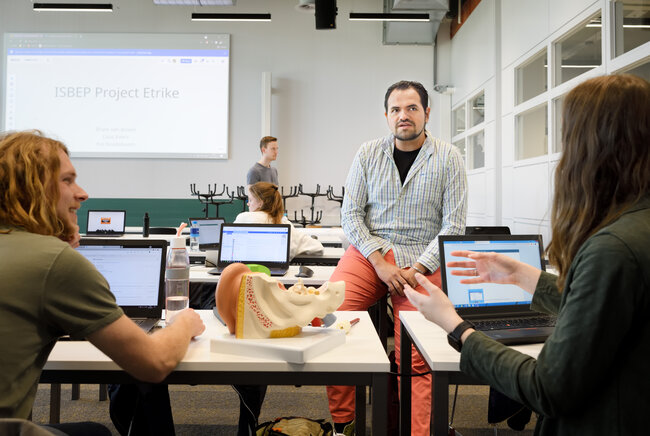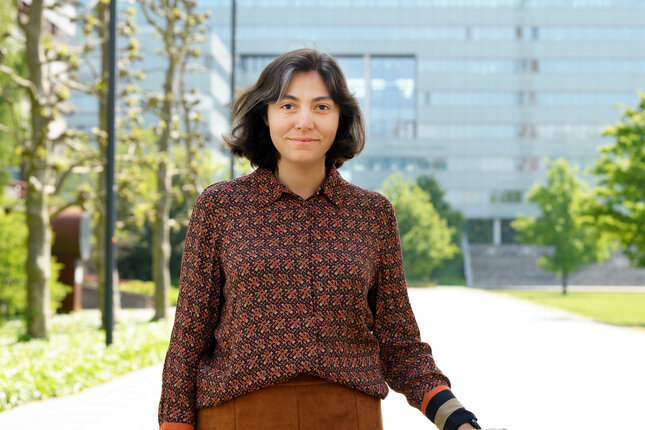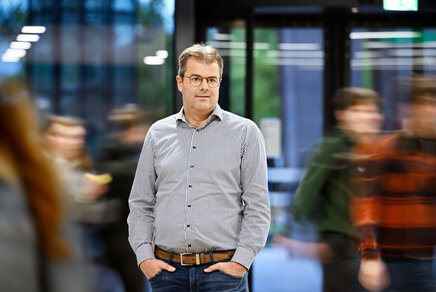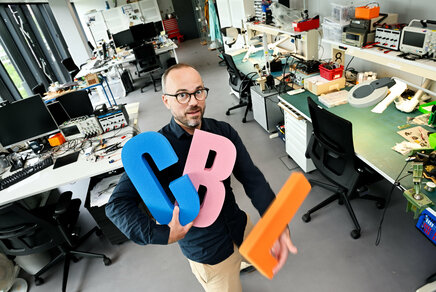Hybrid teachers bring industry practice into the lecture hall
Hybrid teachers from industry provide the link between theory and practice. The Brainport pilot will run until the end of 2022.

It is still something of a well-kept secret, the possibility of using hybrid teachers from industry in education at TU/e. “These people have a wealth of experience and often bring a fresh perspective.” There can be no livelier examples of real-world practice. The pilot run by Brainport has already brought a good number of ‘industry mentors’ to TU/e, but supply is still outstripping demand. To boost take-up, pilot participants are happy to share their experience: “Thanks to hybrid teachers the course could be taught in small groups and there was plenty of opportunity to talk about real-world electronics.”
The supply of hybrid teachers from industry keen to roll up their sleeves at TU/e gives Nadia Hagen no cause for complaint. But in finding more departments and university lecturers keen to have industry-based teachers working alongside them as they deliver their courses, there is room for improvement. This is because, in her experience, many people are still unfamiliar with the Brainport pilot, launched in January 2020, says Hagen, project leader at Education and Student Affairs (ESA). "It is one way we can give our students a bridge to the future. Hybrid lecturers offer a glimpse of the real world, revealing for students what further down the road they can do with the ‘dry’ theory.”
The benefit for our own lecturers, she believes, lies in gaining an extra pair of hands and a mind to help develop and design the education you wish to deliver. “You can deploy hybrid teachers in all sorts of ways: to help supervise bachelor's Graduation Projects, as coaches, to help set up a challenge-based course. These people have a wealth of experience and often bring a fresh perspective.” Hybrid teachers are not required to have a teaching qualification. “They are not responsible for a course, in the main they provide support. As a lecturer, you may find that having them on board frees you up.”
Assistant Professor Peter Ruijten-Dodoiu, coordinator of ISBEP, the bachelor's Graduation Projects within innovation Space, seconds that. For the past three semesters he has placed Ignacio Vazquez of TMC in the role of hybrid teacher on this course. “It saves me a huge amount of time, which I can now spend on my coordinating role." But there are more benefits: "Drawing on my own expertise, my input for the students is relatively abstract while Ignacio can give them concrete examples from the real world.” Psychology & Technology student Delano Gaasbeek values the fresh perspective Vazquez brings. “These are things you don't normally get. He gives a clearer perspective of how things are done in industry. How people join forces to work from a real problem towards a solution.”

Hagen has noticed that some program directors were initially worried they would get people who no longer found their own work challenging. “On the contrary, you get people who are highly motivated, who enjoy sharing their knowledge and who have chosen to give something back to society in this way.”
Hybrid lecturers are highly motivated and are keen to share their knowledge
ESA project leader Nadia Hagen
THE EARLY ADOPTERS
The university lecturers who are already using hybrid lecturers are the early adopters. Professor Kevin Williams of Electrical Engineering is one of them. For the bachelor's course Circuits he brought in twelve hybrid lecturers this year, drawn from ASML, Philips Healthcare and TMC. “When a course is as big as this one (between 150 and 180 students, ed.) it's important to build a good connection with the students. You can deliver a lecture to a large audience to share knowledge and insights, but that is so impersonal. It's only in small groups that you can really have good contact with each other. Added to which, the methods you teach students during lectures can sometimes seem remote from what happens in the real world. How would you apply that?” comes up. This is exactly where the hybrid lecturers, or industry mentors as Williams calls them, can play a valuable role.
Seeking just the right role within the course for the mentors was done in conjunction with them. “We didn't want them helping with homework, we have good student assistants for that. No, their job was to make sure that our students' imagination was triggered, that they learned to see the theory in the context of real-world situations. The small groups make plenty of interaction possible and create the time and opportunity to talk about real-world electronics.”

Ellaheh Barzegar, design engineer at ASML, was one of the hybrid lecturers on the Circuits course. For four hours a week she supervised two groups of students. “The Circuits course really is fundamental electrical engineering,” says Barzegar. “My role was to enter into a dialogue with students and show them how we apply things at ASML. I thoroughly enjoy meeting the younger generation in this way.”
Barzegar herself took the post-master's in Mathematics for Industry and did her doctoral research at TU/e. “It's my way of giving something back to the university. When I was studying in Iran, I felt a strong need to know why I had to learn something. What I would be able to do with it in the future. As a hybrid lecturer, this is exactly where I can play a role.”
Unfortunately COVID put in an appearance, and like everyone else hybrid lecturers had to comply with the requirement to give their lessons online. It was a daunting task for our lecturers, let alone for hybrid lecturers. “The default adopted by students during online lessons is camera out and microphone on mute. It is so difficult to get any interaction going with a blank wall of names,” knows Susan Hommerson. She is a policy officer in medical/device research at General Affairs and coordinator of the third-year course Quality of Life at the Biomedical Engineering department. This is a challenge-based course in which students work in groups to come up with a solution to improve the quality of life in hospitals. It includes guest lectures by professor and cardiologist Lukas Dekker and clinical physicist Carola van Pul. These are followed by the ideation phase in which students work towards a prototype.
STIMULATING THE CREATIVE PROCESS
“Online brainstorming and working in this way to come up with a good idea is not something that all students do with equal ease,” says Hommerson. “This prompted me to seek a way of encouraging the creative process. I was keen to offer tools, starting points for working together within a group on a problem.” Via innovation Space she heard that hybrid lecturer Ignacio Vazquez was giving workshops on ideation. And for this course too he was keen to host a workshop. He put the focus on bridging the communication gap between the medical world and engineers. “They don't share a common language because they come from different disciplines,” says Vazquez (for his story see the panel below). “I offered them tools to visualize the material they are working on, putting their discipline aside for a moment, and this promotes better communication.”
Hommerson is enthusiastic about Vazquez's input: “His workshop was highly customized, he offered plenty of tips and tricks. It gave students a glimpse of real-world practice. It taught them that their reasoning processes need to stem not only from their own knowledge, but also from the environment in which they will soon be employed. You need to be designing for the end-user, whether that's a patient or a doctor. It is this mindset that I hope to instill in students. It's not just a matter of mastering all the material covered by the exam, you also have to reflect on your role in society whether as a university or an engineer.”
WHY COMPANIES ARE KEEN TO ‘LOAN’ OUT THEIR EMPLOYEES
‘Loaning’ your employees to an educational institution for a couple of hours a month for an extended period. What's in it for companies? Nadia Hagen of ESA hears feedback from companies that those members of their staff who do this become more motivated. Maik van der Linden, HR Talent Acquisition Program Manager at ASML, is familiar with this. “Taking on the role of hybrid lecturer for a day injects variety into the working week, and it refreshes your knowledge.”
Not, it should be said, that ASML found this the most compelling reason for embracing the pilot involving hybrid lecturers. “We want to give something back to society; we want to get school pupils in secondary education enthusiastic about technical fields and we want our employees to engage in personal development. Increasingly, our employees need to be skilful at conveying knowledge. When they venture into education, they find themselves training precisely these skills.”
Our employees train their social skills as a hybrid teacher
Maik van der Linden, HR Talent Acquisition Program Manager at ASML
Likewise, at high-tech consultancy company TMC they are convinced of the added value of hybrid lecturers. For the educational institutions, for the companies as well as for the employees themselves, says Lotte Geertsen, director of TMC Entrepreneurial Lab (TEL). “We all know that in the Brainport region we have a pressing need for technical talent, the young women and men of tomorrow. There are shortages in all sorts of areas required to train them and equip them with everything they will need when they enter the job market.”
An important part of this equipment is having recent first-hand knowledge of industry, and voilà: enter the hybrid lecturers. “The motivation of our people is twofold: they want to pass on their knowledge; and they are keen to develop as individuals, in the personal, social, pedagogical and didactic spheres. So it is highly beneficial to both themselves and to us,” says Geertsen, whose investment of her own time in this pilot is considerable, partly because she is committed to matching the right people with the right educational institutions.
“This is a time-consuming endeavor that involves plenty of coordination; it all takes effort. Education and industry are two different ecosystems; their working days are different, the year has a different pattern. This requires adaptability in terms of rhythm and attitude.” She compares the process with learning to dance with a partner. “You tread on each other's toes a couple of times, discover what doesn't work, and then you try again. But in time you find yourselves dancing together.”
In 2020 ASML employees clocked up a total of nearly 3,300 hours working as hybrid lecturers. No fewer than four hundred employees are interested in becoming a hybrid lecturer, while twenty are currently active. “That's not the full picture,” says Van der Linden, adding some nuance. “Some of these people work for a block or semester, and then that's it. The next time that block is taught, they start afresh.” This is how it has been for Ellaheh Barzegar. In September the Circuits course will begin again at Electrical Engineering and she will probably supervise new groups of students. “I hope by then I'll be able to do it in real life instead of online.”
Pool hybrid teachers
Project leader Nadia Hagen of ESA is looking into possibilities for recruiting more hybrid lecturers and deploying them at TU/e. A pool of lecturers from which individuals can be ‘plucked’ would be ideal. She'll be paying attention to alumni, a community with a wealth of industry-based knowledge. Surely good for likely candidates. “And it's also a way we can continue to maintain their involvement with the university.”
HYBRID TECH LECTURERS PILOTED IN BRAINPORT
A hundred hybrid lecturers from industry, active in a teaching capacity, one day a week within the Brainport region, this is the aim of the two-year pilot Hybrid Tech Lecturers, which got underway in January 2020. These lecturers from industry bring real-world practice into the classroom and lecture halls.
Mieke Zijlstra is the pilot's project leader representing Brainport Development. “The main aims are to build a stronger connection between education and industry and to boost the quality of education,” Zijlstra explains. The pilot is not intended to solve the shortage of teaching staff - hybrid lecturers are available one day a week on average, and this varies per assignment.
To date 66 hybrid lecturers (from 14 companies, ranging from large corporates like ASML to small and medium-sized enterprises and sole traders) have been deployed in education. The setting ranges from primary education to university level; TU/e and Fontys University of Applied Sciences are major consumers. This is laid down in a contract. The educational institution pays a fee to the company loaning out an employee as a lecturer.
Finding a match between a hybrid lecturer and an educational institution is the work of two matchmakers at Brainport Development. What does the educational institution need, what role needs filling, who is suitable. “Sometimes people are skeptical and wonder whether hybrid lecturers are sufficiently dedicated, since they are present so infrequently. But once the partnership is up and running, the reactions are very positive,” Zijlstra knows from experience.
Like to know more?
Are you a lecturer at TU/e and are you now keen to involve hybrid lecturers in the education you deliver? Here you will find everything you need to know about requesting a hybrid lecturer (NB: this is an intranet page). Are you working in industry and keen to apply to become a hybrid lecturer, then click here.
Read more about hybrid teaching at TU/e in this article.
More on our strategy




